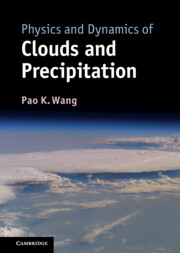Book contents
- Frontmatter
- Contents
- Preface
- 1 Observation of clouds
- 2 The shape and size of cloud and precipitation particles
- 3 Molecular structures of water substance
- 4 Bulk thermodynamic equilibrium among water vapor, liquid water, and ice
- 5 Surface thermodynamics of water substance
- 6 Aerosol in the atmosphere
- 7 Nucleation
- 8 Hydrodynamics of cloud and precipitation particles
- 9 Diffusion growth and evaporation of cloud and precipitation particles
- 10 Collision, coalescence, breakup, and melting
- 11 Cloud drop population dynamics in the warm rain process
- 12 Fundamental cloud dynamics
- 13 Numerical cloud models
- 14 Cloud electricity
- 15 Clouds–environment interaction
- References
- Index
- Plate section
3 - Molecular structures of water substance
Published online by Cambridge University Press: 05 March 2013
- Frontmatter
- Contents
- Preface
- 1 Observation of clouds
- 2 The shape and size of cloud and precipitation particles
- 3 Molecular structures of water substance
- 4 Bulk thermodynamic equilibrium among water vapor, liquid water, and ice
- 5 Surface thermodynamics of water substance
- 6 Aerosol in the atmosphere
- 7 Nucleation
- 8 Hydrodynamics of cloud and precipitation particles
- 9 Diffusion growth and evaporation of cloud and precipitation particles
- 10 Collision, coalescence, breakup, and melting
- 11 Cloud drop population dynamics in the warm rain process
- 12 Fundamental cloud dynamics
- 13 Numerical cloud models
- 14 Cloud electricity
- 15 Clouds–environment interaction
- References
- Index
- Plate section
Summary
Clouds are made of water in all three phases – vapor, liquid, and solid – and they can turn into each other via phase change under specific environmental conditions. We are visualizing these phase changes when we see clouds grow or dissipate, and when we see rain or snow coming out of precipitating clouds. To fully appreciate how these phase changes occur and what the end products are in such processes, we need to understand the molecular structure of water substance in different phases. We shall start with that of a single water molecule. Then we will discuss water vapor, which is essentially an ensemble of weakly interacting water molecules. Next we will look at the solid phase – ice – which is an ensemble of strongly interacting water molecules. We will treat liquid water last because, surprisingly, it is the most complicated of the three, even though it is probably the most familiar to us in our daily life.
Single water molecule
A water molecule is composed of two hydrogen atoms and one oxygen atom, H2O, and hence is a triatomic molecule. But how do these atoms arrange themselves geometrically in a molecule? We call such structure the molecular structure. To fully explain it, we would need to invoke quantum mechanics, which is beyond the scope of this book. The discipline of quantum chemistry is the proper forum for that type of discussion. Here we will use the somewhat simplified “chemical bond” model to describe such structures.
- Type
- Chapter
- Information
- Physics and Dynamics of Clouds and Precipitation , pp. 68 - 85Publisher: Cambridge University PressPrint publication year: 2013



